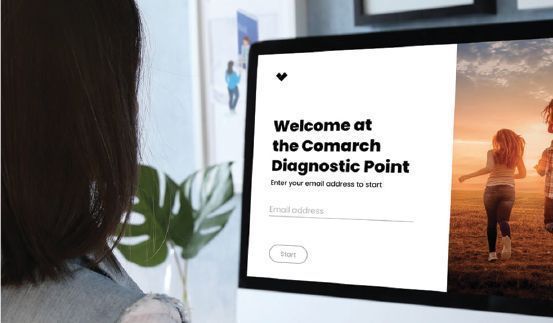HealthManagement, Volume 21 - Issue 7, 2021
A case study of Comarch Diagnostic Point and its application and results at a large organisation with twenty offices in Italy.

We speak a lot about equity, equal treatment, equal access to care. But does it include workplaces? After all, we all spend a lot of time there. Employers care for their employees health in many ways. But how can a big company with several offices all over the country or all over the world provide its employees equal treatment in terms of well-being?
One of the cases that Comarch has faced was a big company with around 20 offices in different spots in Italy. The biggest one, with thousands of employees in one building, has a physician always at employees’ disposal. The rest didn’t have such a service, mainly because they had less than a hundred employees. But, of course, they were all equally important as those in the main office.
The HR department started to wonder what to do to grant all the employees equal treatment and privileges. It would be unimaginable to hire 20 physicians and place them each in one office. It would be too expensive for the frequency in which employees would go to visit.
But sometimes, it’s not the case of physical access. It’s about the connection.
Here comes a use case that Comarch made to help with this issue. The project started with a PoC in one of their offices a few months before the COVID-19 pandemic. There was an unused, small room where it was possible to set up a Comarch Diagnostic Point. It is a point of care where a person can register, make some self-measurement for example event ECG, blood pressure, or saturation, and if needed, a video call with a company’s physician.
Results
In the first month of PoC, more than 80 employees used Comarch Diagnostic Point for self-measurement. In fifteen cases, there was a suspicion of hypertension and Diagnostic Point users were recommended to contact their GP or cardiologist for further screening. There was a suspicion of cardiac arrhythmias in eight cases, and more detailed ECG exams were recommended. Two of the workers who made the screening in Diagnostic Point had low blood pressure, and three suffered from bradycardia.
Prevention Is Better Than Cure
The greatest result of this project was the prevention of some future major events that could have been fatal for some of the employees that took part in this test. It has been demonstrated that, for example, frequent control and lowering of blood pressure can prevent cardiovascular disease (Ettehad et al. 2016). Curing those conditions is much more costly and uses way more resources than a simple control. Thus, it’s a great idea to give people the opportunity to check it even in the workplace and if anything is wrong, contact the physician directly with a video-call.
In terms of money for the employer, it’s easy to deduce that most of these events would cause longer work absence for diagnosis and sick leave in the future, and that would cause higher expenses for the company. In the United States, approximately 140 million working days are wasted every year due to health-related absenteeism. Entrepreneurs stand to lose about $14.6 billion annually due to employee absenteeism for health reasons. Moreover, every year, more than 300,000 employees stop working and start collecting state health benefits following a long period of absence from work (Black and Forest 2011).
Last but not least: the cost of the solution itself. In this case, the company chose to keep one physician, as it was before, and installed less expensive but more efficient Diagnostic Points. The other option would be to hire other 19 physicians, who would probably usually work just for a few hours a day since they didn’t have enough patients to visit.
Come Back to the Office After the Pandemic
Nowadays, the challenge is even higher. The COVID-19 pandemic has taught us to appreciate new technologies even more because they enable us to take care of ourselves and our employees.
Most companies are slowly going back to the offices, even if in hybrid mode, but workplaces are perceived much differently by employees. Even with the vaccinations, we will probably see next waves of coronavirus, and, with that in mind, people value their health even more.
Employees want to be secure and want assurance that they will receive good care if they are unwell. Giving them the possibility to check their temperature, saturation, and other vital parameters and having the possibility to speak with a physician whenever they need, would not only improve their wellbeing but also increase their sense of security.
Disclosure of conflict of interest: Point-of-View articles are the sole opinion of the author(s) and they are part of the HealthManagement.org Corporate Engagement or Educational Community Programme.
References:
Black DC, Frost D (2011) Health at work - an independent review of sickness absence. Presented to Parliament by the Secretary of State for Work and Pensions by Command of Her Majesty.
Ettehad D, Emdin CA, Kiran A et al. (2016) Blood pressure lowering for prevention of cardiovascular disease and death: a systematic review and meta-analysis. Lancet, 5;387(10022):957-967.



